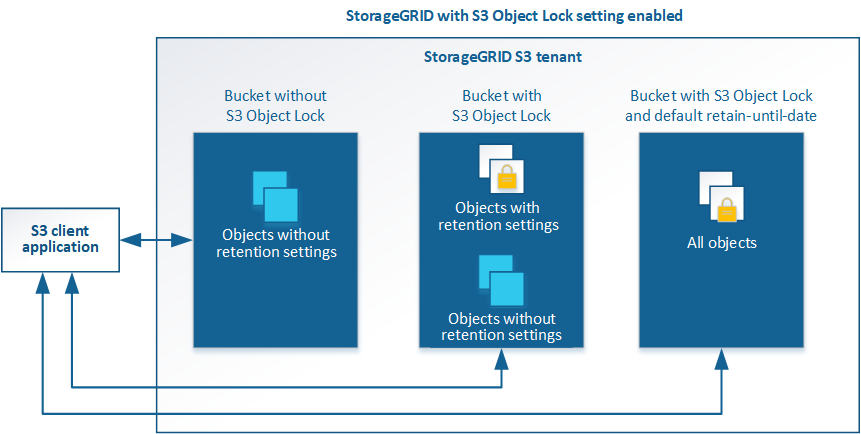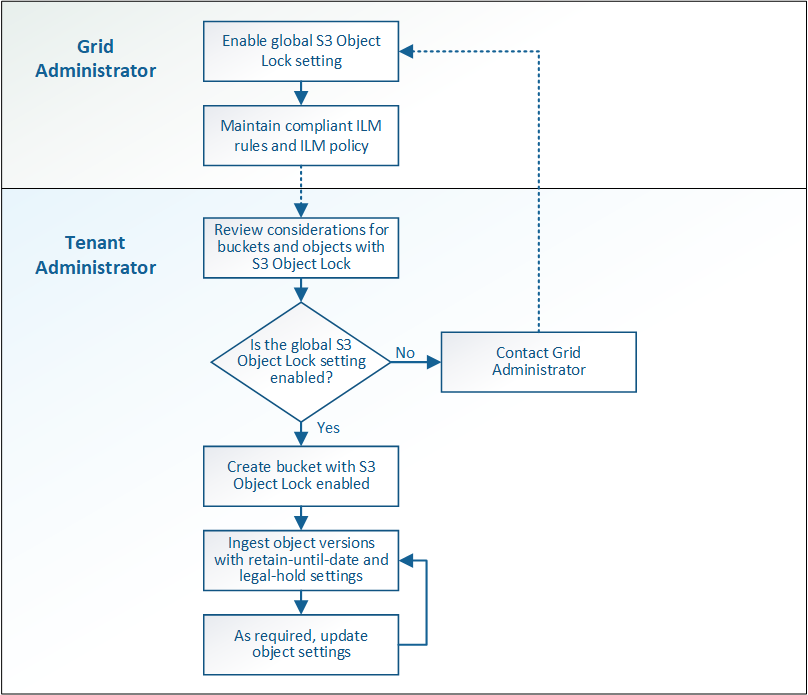Use S3 Object Lock with tenants
 Suggest changes
Suggest changes


You can use the S3 Object Lock feature in StorageGRID if your objects must comply with regulatory requirements for retention.
What is S3 Object Lock?
The StorageGRID S3 Object Lock feature is an object-protection solution that is equivalent to S3 Object Lock in Amazon Simple Storage Service (Amazon S3).
As shown in the figure, when the global S3 Object Lock setting is enabled for a StorageGRID system, an S3 tenant account can create buckets with or without S3 Object Lock enabled. If a bucket has S3 Object Lock enabled, S3 client applications can optionally specify retention settings for any object version in that bucket. An object version must have retention settings specified to be protected by S3 Object Lock.

The StorageGRID S3 Object Lock feature provides a single retention mode that is equivalent to the Amazon S3 compliance mode. By default, a protected object version cannot be overwritten or deleted by any user. The StorageGRID S3 Object Lock feature does not support a governance mode, and it does not allow users with special permissions to bypass retention settings or to delete protected objects.
If a bucket has S3 Object Lock enabled, the S3 client application can optionally specify either or both of the following object-level retention settings when creating or updating an object:
-
Retain-until-date: If an object version's retain-until-date is in the future, the object can be retrieved, but it cannot be modified or deleted. As required, an object's retain-until-date can be increased, but this date cannot be decreased.
-
Legal hold: Applying a legal hold to an object version immediately locks that object. For example, you might need to put a legal hold on an object that is related to an investigation or legal dispute. A legal hold has no expiration date, but remains in place until it is explicitly removed. Legal holds are independent of the retain-until-date.
You can also specify a default retention mode and default retention period for the bucket. These are applied to each object added to the bucket that does not specify its own retention settings.
For details on these settings, see Use S3 object lock.
Manage legacy Compliant buckets
The S3 Object Lock feature replaces the Compliance feature that was available in previous StorageGRID versions. If you created compliant buckets using a previous version of StorageGRID, you can continue to manage the settings of these buckets; however, you can no longer create new compliant buckets. For instructions, see the NetApp Knowledge Base article.
S3 Object Lock workflow
The workflow diagram shows the high-level steps for using the S3 Object Lock feature in StorageGRID.
Before you can create buckets with S3 Object Lock enabled, the grid administrator must enable the global S3 Object Lock setting for the entire StorageGRID system. The grid administrator must also ensure that the information lifecycle management (ILM) policy is “compliant”; it must meet the requirements of buckets with S3 Object Lock enabled. For details, contact your grid administrator or see the instructions for managing objects with information lifecycle management.
After the global S3 Object Lock setting has been enabled, you can create buckets with S3 Object Lock enabled. You can then use the S3 client application to optionally specify retention settings for each object version.

Requirements for S3 Object Lock
Before enabling S3 Object Lock for a bucket, review the requirements for S3 Object Lock buckets and objects and the lifecycle of objects in buckets with S3 Object Lock enabled.
Requirements for buckets with S3 Object Lock enabled
-
If the global S3 Object Lock setting is enabled for the StorageGRID system, you can use the Tenant Manager, the Tenant Management API, or the S3 REST API to create buckets with S3 Object Lock enabled.
This example from the Tenant Manager shows a bucket with S3 Object Lock enabled.

-
If you plan to use S3 Object Lock, you must enable S3 Object Lock when you create the bucket. You cannot enable S3 Object Lock for an existing bucket.
-
Bucket versioning is required with S3 Object Lock. When S3 Object Lock is enabled for a bucket, StorageGRID automatically enables versioning for that bucket.
-
After you create a bucket with S3 Object Lock enabled, you cannot disable S3 Object Lock or suspend versioning for that bucket.
-
Optionally, you can configure default retention for a bucket. When an object version is uploaded, the default retention is applied to the object version. You can override the bucket default by specifying a retention mode and retain-until-date in the request to upload an object version.
-
Bucket lifecycle configuration is supported for S3 Object Lifecycle buckets.
-
CloudMirror replication is not supported for buckets with S3 Object Lock enabled.
Requirements for objects in buckets with S3 Object Lock enabled
-
To protect an object version, the S3 client application must either configure bucket default retention, or specify retention settings in each upload request.
-
You can increase the retain-until-date for an object version, but you can never decrease this value.
-
If you are notified of a pending legal action or regulatory investigation, you can preserve relevant information by placing a legal hold on an object version. When an object version is under a legal hold, that object cannot be deleted from StorageGRID, even if it has reached its retain-until-date. As soon as the legal hold is lifted,the object version can be deleted if the retain-until-date has been reached.
-
S3 Object Lock requires the use of versioned buckets. Retention settings apply to individual object versions. An object version can have both a retain-until-date and a legal hold setting, one but not the other, or neither. Specifying a retain-until-date or a legal hold setting for an object protects only the version specified in the request. You can create new versions of the object, while the previous version of the object remains locked.
Lifecycle of objects in buckets with S3 Object Lock enabled
Each object that is saved in a bucket with S3 Object Lock enabled goes through three stages:
-
Object ingest
-
When adding an object version to a bucket with S3 Object Lock enabled, the S3 client application can optionally specify retention settings for the object (retain-until-date, legal hold, or both). StorageGRID then generates metadata for that object, which includes a unique object identifier (UUID) and the ingest date and time.
-
After an object version with retention settings is ingested, its data and S3 user-defined metadata cannot be modified.
-
StorageGRID stores the object metadata independently of the object data. It maintains three copies of all object metadata at each site.
-
-
Object retention
-
Multiple copies of the object are stored by StorageGRID. The exact number and type of copies and the storage locations are determined by the compliant rules in the active ILM policy.
-
-
Object deletion
-
An object can be deleted when its retain-until-date is reached.
-
An object that is under a legal hold cannot be deleted.
-


